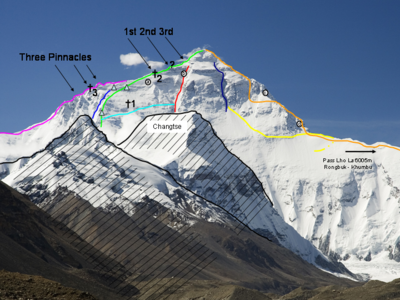George Ingle Finch
George Ingle Finch (born August 4, 1888 in Australia , † November 22, 1970 ) was an Australian chemist and mountaineer . He grew up in the German-speaking part of Switzerland and later studied physics at the University of Geneva . Between 1936 and 1952 he was a professor of applied chemistry at Imperial College London .
Live and act
Finch had applied for the 1921 exploration expedition of the Everest Committee, which had founded the Royal Geographical Society with the Alpine Club , but had been rejected because of alleged health concerns. The rejection was more likely to be explained by Finch's “not fitting” into the “ Oxbridge ” club culture of the Alpine Club.

green: normal route, in large parts the Mallory route 1924, high camps at approx. 7700 and 8300 m
red: Norton-Couloir
(a): approx. 8330m, George Ingle Finch 1922
(b ): approx. 8573m, Edward Felix Norton 1924
+1: Location G.Mallory
Finch was then a member of the second British expedition on Mount Everest under the leadership of Brigadier Charles G. Bruce . Finch had previously undertaken extensive experiments with Georges Dreyer at the University of Glasgow on the use of bottled oxygen, including experiments in negative pressure chambers in which heights of 9,000 to 10,000 meters could be simulated. As a result of these attempts, Finch became the most convincing advocate of the use of so-called "English air", a bon mot that the Sherpas of the 1922 expedition then coined about bottled oxygen. Finch's medical research into the use of bottled oxygen in the death zone remained crucial for many more expeditions to the 8000ers until 1980 . Even the skeptical George Mallory had been so convinced by Finch's and others' achievements in attempting walking with oxygen at great heights that Mallory's last attempt at the summit was made with oxygen - the attempt in which Mallory and his companion Andrew Irvine were killed.
On May 23, 1922, Finch and Captain J. Geoffrey Bruce, the expedition leader's cousin, reached an elevation of 27,300 feet (about 8,330 meters) on the north face of Mount Everest before turning back. He fell out with the Everest Committee after 1922 because of disputes over book and lecture fees and subsequently did not take part in the 1924 expedition to Everest. (The Everest Committee had reserved all photo, lecture and publication rights restrictively, but Finch was not the only one to deal with lectures in Switzerland).
In the Alps , Finch was the first to climb the north face diagonals (or "Finch Route") on Dent d'Hérens , which he climbed on August 2, 1923 together with TGB Forster and R. Peto. Finch was elected a member ("Fellow") of the Royal Society in 1938 and won the Hughes Medal in 1944 . He was a lifelong advocate and supporter of the Alpine Club , although in the 1920s some of the members were critical of him because of his simple background, his upbringing away from English schools and his behavior as a loner and "leaderless" of the mountains of the Alps. Finch later also became president of the Alpine Club.
Web links
- imagingeverest: Professor George Ingle Finch, FRS
- TS Blakeney: Obituary: George Ingle Finch. In: The Geographical Journal, Vol. 137, No. 1 (Mar., 1971), p. 136, doi : 10.2307 / 1795428 (currently unavailable) , JSTOR 1795428
- M. Blackman: George Ingle Finch. 1888-1970 . In: Biographical Memoirs of Fellows of the Royal Society, Vol. 18, (Nov., 1972), pp. 222-239 JSTOR 769660
literature
- Walter Bauer: Mount Everest. Report from Mallory and his friends. Gütersloh: C. Bertelsmann Verlag 1953
- Jochen Hemmleb and Eric Simonson: Detectives on Everest; The Mountaineers Books, Seattle 2002
- George Ingle Finch: The fight for Everest, German by Walter Schmidtkunz; FA Brockhaus, Leipzig 1925
- Tom Holzel, Audrey Salkeld: In the Death Zone - The Secret of George Mallory; Goldmann, Munich 1999, ISBN 3-442-15076-0
Individual evidence
| personal data | |
|---|---|
| SURNAME | Finch, George Ingle |
| BRIEF DESCRIPTION | Australian chemist and climber |
| DATE OF BIRTH | 4th August 1888 |
| PLACE OF BIRTH | Australia |
| DATE OF DEATH | November 22, 1970 |
